Family name: Ranunculaceae Jussieu
Synonym(s): Aconitaceae Bercht. & J. Presl; Actaeaceae Bercht. & J. Presl; Anemonaceae Vest; Aquilegiaceae Lilja; Cimicifugaceae Bromhead; Coptaceae Á. Löve & D. Löve, nom. inval.; Glaucidiaceae Tamura; Helleboraceae Vest; Hydrastidaceae Martinov; Nigellaceae J. Agardh; Thalictraceae Raf.
Common name(s): buttercup family
*Number of genera/species: 56/2,346
List of genera records in GRIN-Global
Fruit usually a folliclefollicle:
a dry to (rarely) fleshy fruit derived from a single carpel that opens along a single longitudinal suture, derived from a single, superior, simple ovary; the seeds may be arillate or with a fleshy testa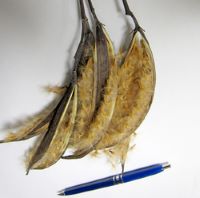 or an acheneachene:
or an acheneachene:
a dry, indehiscent, one-seeded fruit, with seed attached to pericarp at a single point, derived from a single, superior, simple or compound, one-loculed ovary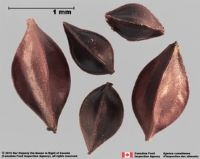 , rarely berryberry:
, rarely berryberry:
an indehiscent, fleshy fruit with one or a few to many seeds. The flesh may be homogenous throughout. Or, if the outer part is hard, firm, or leathery, referred to as an hesperidium. Septa are present in some, and the seeds may be arillate or with a fleshy testa.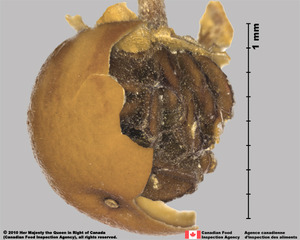 (e.g. Actaea, Hydrastis), 0.6–55 mm long, globoseglobose:
(e.g. Actaea, Hydrastis), 0.6–55 mm long, globoseglobose:
3D shape—more or less spherical to angularangular:
to angularangular:
2D shape—having sides that meet at acute or obtuse angles
, straight, bentbent:
(of embryo) embryo is bent at an acute, V-shaped angle with the ends close together and generally thick cotyledons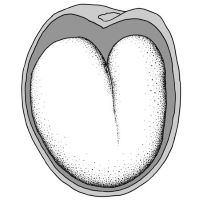 , or distinctly curvedcurved:
, or distinctly curvedcurved:
(of embryo) linear embryo is curved into an arch or horseshoe with the ends far apart , tereteterete:
, tereteterete:
approximately circular in cross section; width and thickness approximately equal
 , compressedcompressed:
, compressedcompressed:
flattened; in grasses, used to denote compression (not necessarily flattened) either laterally or dorsiventrally
, or angularangular:
2D shape—having sides that meet at acute or obtuse angles
in transection, stylestyle:
in a flower, the narrow and elongated part of the pistil between the stigma and the ovary; sometimes persisting in fruit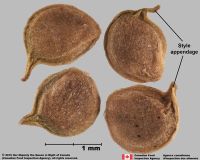 persistent forming short to long, erect or curvedcurved:
persistent forming short to long, erect or curvedcurved:
(of embryo) linear embryo is curved into an arch or horseshoe with the ends far apart beakbeak:
beakbeak:
a usually firm, terminal appendage, sometimes tapered , if beakedbeak:
, if beakedbeak:
a usually firm, terminal appendage, sometimes tapered , beakbeak:
, beakbeak:
a usually firm, terminal appendage, sometimes tapered 1–100 mm long, sometimes winged, with one to many seeds. Pericarppericarp:
1–100 mm long, sometimes winged, with one to many seeds. Pericarppericarp:
fruit wall or fruit coat
brown, black, purple, green, red, orange, yellow, or white, dulldull:
reflecting only a low proportion of incident light, with no apparent sheen or shinyshiny:
or shinyshiny:
uniformly reflecting a high proportion of incident light at all angles , thick or thin, leatheryleathery:
, thick or thin, leatheryleathery:
texture—moderately thick, tough, and very pliable
, membranousmembranous:
texture—extremely thin, pliable, and fairly tough
, or paperypapery:
texture—papyraceous, chartaceous; very thin, pliable, and readily torn; like paper
, rarely spongyspongy:
soft, light, discontinuous but cohesive, and somewhat resilient
, glabrousglabrous:
without hairs
or pubescentpubescent:
surface relief—bearing hairs
, smooth or keeledkeel:
a longitudinal ridge, like the keel of a boat, formed by the lengthwise folding of a structure, such as a lemma or palea
 , ridgedridged:
, ridgedridged:
surface relief—raised, thick ridges, sharp edged or rounded, usually in a series that may cover the entire surface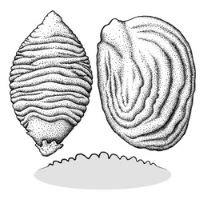 , ribbedribbed:
, ribbedribbed:
surface relief—wide, prominent, linear ridges that are generally rounded and longitudinally situated on the surface , often prominently veinedveined:
, often prominently veinedveined:
surface relief—lines that intersect in a vein pattern that is flush or slightly raised from the surface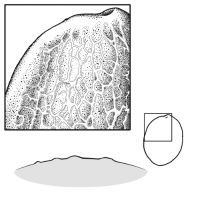 , or variously sculptured, or with spines or bristles. Often fruits, few to 60+, aggregated into a globoseglobose:
, or variously sculptured, or with spines or bristles. Often fruits, few to 60+, aggregated into a globoseglobose:
3D shape—more or less spherical to cylindricalcylindrical:
to cylindricalcylindrical:
3D shape—a cylinder, with parallel sides and a circular cross-section; tubular or rod-shaped
head. Fruits erect to divaricate in head, free or connate, if fully connate, then forming a capsulecapsule:
a dry, dehiscent fruit derived from a compound ovary (e.g. Helleborus spp., Nigella spp.), heads 0.3–30 mm long.
(e.g. Helleborus spp., Nigella spp.), heads 0.3–30 mm long.
Seeds globoseglobose:
3D shape—more or less spherical to angularangular:
to angularangular:
2D shape—having sides that meet at acute or obtuse angles
, compressedcompressed:
flattened; in grasses, used to denote compression (not necessarily flattened) either laterally or dorsiventrally
, tereteterete:
approximately circular in cross section; width and thickness approximately equal
 , or flattened in transection, 0.5–14 mm long. Usually wingless. ArilsAril:
, or flattened in transection, 0.5–14 mm long. Usually wingless. ArilsAril:
(broad sense) appendicular structure that wholly or partly envelops a seed and is produced from or a modification of the funicle, raphe, or outer integument; usually fleshy or pulpy, sometimes spongy or tufted-capillate, often brightly colored absent, except carunclescaruncle:
absent, except carunclescaruncle:
a localized outgrowth of the seed coat near the hilum of the seed; it functions as an elaiosome in Caltha and elaiosomeselaiosome:
in Caltha and elaiosomeselaiosome:
a lipid and protein-rich fleshy structure attached to some seeds and fruits, it attracts ants which then disperse the disseminule (e.g., caruncle in the Euphorbiaceae, the aril (outgrowth of the funiculus) in the Fabaceae)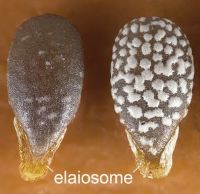 in Helleborus. RaphaeRaphe:
in Helleborus. RaphaeRaphe:
a ridge or seam on the seed coat, formed by the portion of the funiculus united to the ovule wall in longitudinally curved ovules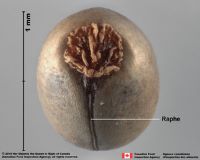 sometimes conspicuous. Seed coat loose, black, brown, purple, gray, reddish, yellow, or white, shinyshiny:
sometimes conspicuous. Seed coat loose, black, brown, purple, gray, reddish, yellow, or white, shinyshiny:
uniformly reflecting a high proportion of incident light at all angles or dulldull:
or dulldull:
reflecting only a low proportion of incident light, with no apparent sheen , smooth or often scalyscaly:
, smooth or often scalyscaly:
surface relief—covered with small, thin, fine scales or flakes that may be removable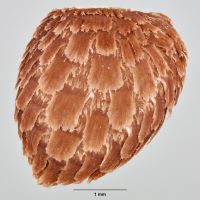 or striatestriate:
or striatestriate:
surface relief—having fine, parallel lines, grooves or ridges , wrinkledwrinkled:
, wrinkledwrinkled:
surface relief—shallow, irregular folds and furrows covering the surface; appearing overall though crumpled and then spread out , wartywarty:
, wartywarty:
surface relief—distinct, rounded projections that are large relative to the fruit size; tuberculate, verrucose , pittedpitted:
, pittedpitted:
surface relief—surface with small depressions in which the areas between the hollows do not take on the appearance of a true reticular net , pustulatepustular:
, pustulatepustular:
surface relief—with small blisters or pustules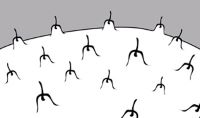 , or spinyspiny:
, or spinyspiny:
having slender, stiff, sharp projections oriented in the general plane of the structure . Hila punctate, often inconspicuous.
. Hila punctate, often inconspicuous.
Embryo rudimentaryrudimentary:
(of embryo) embryo is small and fills less than a quarter of the seed and can be variable in shapes, such as linear, spatulate, or oval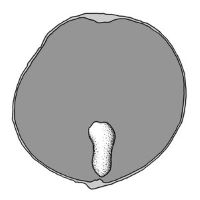 or well developed, often minute, partially or barely filling seed coat, rarely nearly filling seed coat (Glaucidium), axileaxile:
or well developed, often minute, partially or barely filling seed coat, rarely nearly filling seed coat (Glaucidium), axileaxile:
on or of the axis
and centric, linearlinear:
(shape) long, narrow, and uniform in width; (of embryo) embryo is straight and much longer than wide or miniature, straight, embedded in endosperm. Cotyledons, thin and flat, with petioles often fused.
or miniature, straight, embedded in endosperm. Cotyledons, thin and flat, with petioles often fused.
Endosperm copious, hard or fleshy, smooth.
Many species of Ranunculus can be weedy in uplands, crop fields, and gardens and spreads by seed reproduction. Ranunculus acris is considered a noxious weed in Montana. Clematis orientalis is a noxious weed in Colorado.
Aquarium & Pond Plants of the World tool includes descriptions and images of genera, which may be encountered.
| Fruit | |
| Type | folliclefollicle: a dry to (rarely) fleshy fruit derived from a single carpel that opens along a single longitudinal suture, derived from a single, superior, simple ovary; the seeds may be arillate or with a fleshy testa  , acheneachene: , acheneachene:a dry, indehiscent, one-seeded fruit, with seed attached to pericarp at a single point, derived from a single, superior, simple or compound, one-loculed ovary  , berryberry: , berryberry:an indehiscent, fleshy fruit with one or a few to many seeds. The flesh may be homogenous throughout. Or, if the outer part is hard, firm, or leathery, referred to as an hesperidium. Septa are present in some, and the seeds may be arillate or with a fleshy testa.  , rarely capsulecapsule: , rarely capsulecapsule:a dry, dehiscent fruit derived from a compound ovary  |
| Size range | 0.6–55 mm long, main body not including beakbeak: a usually firm, terminal appendage, sometimes tapered  |
| Shape(s) | globoseglobose: 3D shape—more or less spherical  , lens-shapedlens-shaped: , lens-shapedlens-shaped:2D shape—round and flattened with two curved (convex) surfaces , ellipsoidellipsoid: 3D shape—elliptic , oblongoblong: 2D shape—much longer than broad with nearly parallel sides, corners are rounded  , linearlinear: , linearlinear:(shape) long, narrow, and uniform in width; (of embryo) embryo is straight and much longer than wide  , falcatefalcate: , falcatefalcate:shaped like a scythe or sickle  , fusiformfusiform: , fusiformfusiform:spindle-shaped; broadest at the middle and tapering at both ends 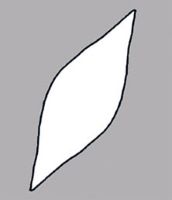 , ovoidovoid: , ovoidovoid:3D shape—ovate  , cylindricalcylindrical: , cylindricalcylindrical:3D shape—a cylinder, with parallel sides and a circular cross-section; tubular or rod-shaped , lanceoloidlanceoloid: 3D shape—lanceolate , rhomboid, angularangular: 2D shape—having sides that meet at acute or obtuse angles , reniformreniform: 2D or 3D shape—kidney-shaped  |
| Texture | thick or thin, leatheryleathery: texture—moderately thick, tough, and very pliable , membranousmembranous: texture—extremely thin, pliable, and fairly tough , paperypapery: texture—papyraceous, chartaceous; very thin, pliable, and readily torn; like paper , rarely spongyspongy: soft, light, discontinuous but cohesive, and somewhat resilient |
| Surface relief | smooth, keeledkeel: a longitudinal ridge, like the keel of a boat, formed by the lengthwise folding of a structure, such as a lemma or palea  , ridgedridged: , ridgedridged:surface relief—raised, thick ridges, sharp edged or rounded, usually in a series that may cover the entire surface  , ribbedribbed: , ribbedribbed:surface relief—wide, prominent, linear ridges that are generally rounded and longitudinally situated on the surface  , reticulatereticulate: , reticulatereticulate:surface relief—netted, raised walls or concave grooves forming a net-like surface pattern with flat, concave, or convex interspaces  , striatestriate: , striatestriate:surface relief—having fine, parallel lines, grooves or ridges  , wrinkledwrinkled: , wrinkledwrinkled:surface relief—shallow, irregular folds and furrows covering the surface; appearing overall though crumpled and then spread out  , often prominently veinedveined: , often prominently veinedveined:surface relief—lines that intersect in a vein pattern that is flush or slightly raised from the surface  , wartywarty: , wartywarty:surface relief—distinct, rounded projections that are large relative to the fruit size; tuberculate, verrucose  , bristlybristly: , bristlybristly:having bristles or stiff hair or hair-like structures 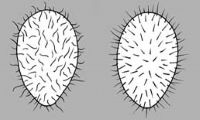 , or spinyspiny: , or spinyspiny:having slender, stiff, sharp projections oriented in the general plane of the structure  |
| Color(s) | brown, black, purple, green, red, orange, yellow, white |
| Unique features | Usually small beakedbeak: a usually firm, terminal appendage, sometimes tapered  follicles or achenesachene: follicles or achenesachene:a dry, indehiscent, one-seeded fruit, with seed attached to pericarp at a single point, derived from a single, superior, simple or compound, one-loculed ovary  , often with long hairs arising along beaks (persistent stylesstyle: , often with long hairs arising along beaks (persistent stylesstyle:in a flower, the narrow and elongated part of the pistil between the stigma and the ovary; sometimes persisting in fruit  ), covered in short hairs, and with abscission scars at the opposite end of beaks. Beaks may be irregularly broken off. Fruits sometimes in heads and connate at least at the base to nearly the length of the fruit. ), covered in short hairs, and with abscission scars at the opposite end of beaks. Beaks may be irregularly broken off. Fruits sometimes in heads and connate at least at the base to nearly the length of the fruit. |
| Seed | |
| Size range | 0.5–14 mm long |
| Shape(s) | globoseglobose: 3D shape—more or less spherical  , ellipsoidellipsoid: , ellipsoidellipsoid:3D shape—elliptic , ovoidovoid: 3D shape—ovate  , oblongoblong: , oblongoblong:2D shape—much longer than broad with nearly parallel sides, corners are rounded  , angularangular: , angularangular:2D shape—having sides that meet at acute or obtuse angles |
| Surface relief | smooth, striatestriate: surface relief—having fine, parallel lines, grooves or ridges  , wrinkledwrinkled: , wrinkledwrinkled:surface relief—shallow, irregular folds and furrows covering the surface; appearing overall though crumpled and then spread out  , wartywarty: , wartywarty:surface relief—distinct, rounded projections that are large relative to the fruit size; tuberculate, verrucose  , pittedpitted: , pittedpitted:surface relief—surface with small depressions in which the areas between the hollows do not take on the appearance of a true reticular net  , pustulatepustular: , pustulatepustular:surface relief—with small blisters or pustules  , scalyscaly: , scalyscaly:surface relief—covered with small, thin, fine scales or flakes that may be removable  , spinyspiny: , spinyspiny:having slender, stiff, sharp projections oriented in the general plane of the structure  |
| Color(s) | black, brown, purple, gray, reddish, yellow, white |
| Unique features | Seeds smooth, wrinkledwrinkled: surface relief—shallow, irregular folds and furrows covering the surface; appearing overall though crumpled and then spread out  , or with small scales, often with a prominent longitudinallongitudinal: , or with small scales, often with a prominent longitudinallongitudinal:of or relating to length or the lengthwise dimension ridge, and frequently with minute embryos, sometimes large, but then embryos fill about 1/2 the length of the seed and are embedded in copious endosperm. HilaHilum: on seeds, the scar indicating where the funiculus was attached; on grass caryopses, the scar visible on the outer fruit surface revealing where the seed is attached on the inner fruit wall surface; or in Asteraceae cypselae, the scar visible on the outer fruit wall revealing where the fruit was attached to the receptacle 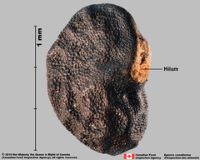 inconspicuous. inconspicuous. |
| Other | |
| Embryo | rudimentaryrudimentary: (of embryo) embryo is small and fills less than a quarter of the seed and can be variable in shapes, such as linear, spatulate, or oval  or well developed, often minute, partially or barely filling seed coat, rarely nearly filling seed coat (Glaucidium), axileaxile: or well developed, often minute, partially or barely filling seed coat, rarely nearly filling seed coat (Glaucidium), axileaxile:on or of the axis and centric, linearlinear: (shape) long, narrow, and uniform in width; (of embryo) embryo is straight and much longer than wide  or miniature, straight, embedded in endosperm. Cotyledoncotyledon: or miniature, straight, embedded in endosperm. Cotyledoncotyledon:a primary leaf of the embryo 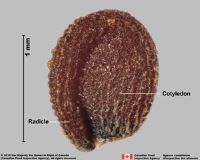 petioles often fused. petioles often fused. |
| Nutritive tissue | endosperm copious, hard or fleshy, smooth |
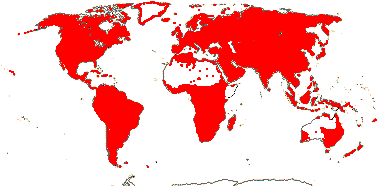
Distribution map courtesy of Angiosperm Phylogeny Website.
Flora of North America Editorial Committee 1993+Flora of North America Editorial Committee 1993+:
Flora of North America Editorial Committee, eds. 1993+. Flora of North America North of Mexico [Online]. 22+ vols. Flora of North America Association, New York and Oxford. Accessed January-March 2024. URL: http://beta.floranorthamerica.org.; Kirkbride et al. 2006Kirkbride et al. 2006:
Kirkbride JH, Jr, Gunn CR, and Dallwitz MJ. 2006. Family guide for fruits and seeds, vers. 1.0. Accessed September 2020-January 2022. URL: https://nt.ars-grin.gov/seedsfruits/keys/frsdfam/index.cfm .; Kubitzki et al. 1990+Kubitzki et al. 1990+:
Kubitzki K et al., eds. 1990+. The families and genera of vascular plants. 7+ vols. Berlin etc.; Takhtajan 2009Takhtajan 2009:
Takhtajan A. 2009. Flowering plants: Second edition. Springer Nature, Switzerland. 871 pp.; USDA 1980USDA 1980:
United States Dept. of Agriculture (USDA). 1980. Major weed family identification guide. Hyattsville Md, United States ; Zhengyi et al. 2004+Zhengyi et al. 2004+:
Zhengyi W, Raven PH, and Deyuan H. 2004+. Flora of China [online]. 25 vols. Science Press, Beijing China & Missouri Botanical Garden, St. Louis USA. Accessed January–March 2024. http://flora.huh.harvard.edu/china/
*The number of genera and species is based on Christenhusz and Byng 2016Christenhusz and Byng 2016:
Christenhusz MJM and Byng JW. 2016. The number of known plant species in the world and its annual increase. Phytotaxa 261 (3): 201-217. https://doi.org/10.11646/phytotaxa.261.3.1, which may differ from the number of genera in GRIN-Global.